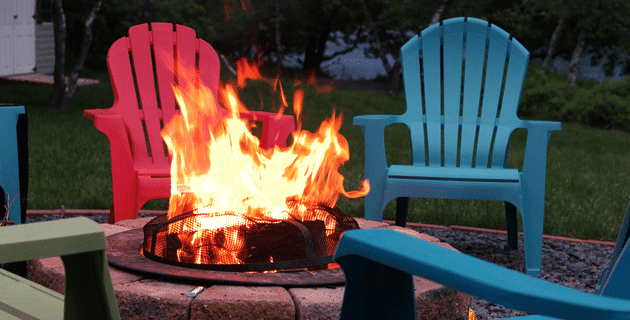
by California Casualty | Homeowners Insurance Info, Safety |
You’re a proud pool owner – or a soon-to-be one. You know how important it is to keep your pool clean, safe, and ready to swim.
We’ve compiled a list of 10 common maintenance mistakes that pool owners make, and how you can avoid them. Use this as your guide to ensure that your pool is ready to enjoy all season long.
1. Don’t ignore your pool’s pH level.
The pH is a measure of how acidic or basic your water is. If your pool’s pH is too low, the water is acidic—which is good to keep away algae but which can damage pool equipment like your pump and filter, heater, vinyl liner, and chemical feeder. When the pH is too high, however, it limits the effectiveness of your chlorine, the chemical that kills pathogens—microorganisms and bacteria that could be present in your pool. Pool pH that is too high also can cause skin rashes. That’s why a balanced pH is important.
Do: Test your pH levels at least twice a week. Keep the pH between 7.2 and 7.8.
2. Don’t add chlorine—or try to shock your pool—on a hot day.
It’s less effective to add chlorine to the water on a hot day. When chlorine is exposed to sunlight, it forms ions that convert to a gas that releases into the atmosphere. That requires you to add more chlorine for the right effect. Shocking—or adding a chemical mixture with a high dose of chlorine—has a similar effect. While you may want to do a shock treatment that helps to get rid of chloramines that can irritate eyes and skin, daytime is not the right time to do it.
Do: Add chlorine when temperatures are cooler, such as during the evening. Shock your pool once a week at night.
Pro Tip: Don’t think a strong chlorine smell means your pool has too much chlorine. When some contaminants in your pool oxidize, they can give off the scent of chlorine. If you smell chlorine, test your pool’s chlorine level. If needed, add chlorine until the water gives a reading between 3 and 5 parts per million (ppm).
3. Don’t do a shock treatment through your skimmer or put the shock chemicals directly into your pool without diluting them first.
Combining pool shock and chlorine can create a deadly gas, which can explode. That’s why you never want to add a shock treatment to a filter system with an automatic chlorinator. Putting those chemicals together in a confined space can cause an explosion in your pool’s filter system. Pool owners also have been burned and severely injured by mishandling of these chemicals. In addition, you don’t want to add shock directly into your pool. Shock is a form of concentrated chlorine; it can bleach anything within contact. Always dissolve the chemical into a bucket full of water. That will ensure it’s more evenly dispersed and it will protect your pool walls and floor.
Do: Follow manufacturer instructions when adding shock. Always wear proper safety gear.
Pro Tip: When diluting shock, put water in the bucket first and then add the chemicals. Putting chemicals in first can cause them to splash back on your arms or face.
4. Don’t run the pool filter system less than 8 hours each day.
Your pool’s filter and pump push water in and out of the system, cleaning it of dirt and keeping pool chemicals mixed. While running it less may seem like a cost-saving measure, it’s not. Inadequate pool filtering leads to more expensive treatments to remove algae and critters in your pool. While the size of your pool does matter, for most pools, 8 hours should do the trick.
Do: Keep your pool filter running at least 8 hours a day so it can do its job.
5. Don’t forget to brush.
Regular vacuuming helps to clear your pool of debris. Regular brushing helps to get those problem spots like the waterline, steps, and stairs, and behind ladders, corners and crevices. This helps to keep algae and other unwanted substances under control.
Do: Use an extra wide, heavy-duty aluminum pool brush with curved edges. Brush every week or more often if your pool is often used.
6. Don’t try to fix an algae problem with an automatic pool cleaner.
A robot simply pushes debris and algae around, and up through a mesh bag where it can clog. In other words, if you’re using an automatic pool cleaner, you’re just spreading the problem around. You’re not removing it.
Do: Use a manual vacuum. Make sure you either remove the drain plug or switch your filter to waste.
7. Don’t forget to check your calcium level.
Calcium helps to protect concrete, plaster, fiberglass, and vinyl. However, too much calcium makes the water cloudy. Again, you have to strive for that perfect balance. The recommended range is 175 to 225 parts per million (ppm).
Do: Check your calcium levels and as needed, add some calcium hardness increaser to the water. Note if you’re using calcium hypochlorite shock, you’re already adding calcium when you do the shock treatment.
8. Don’t backwash your pool filter too often.
Debris builds up in your pool’s filter over time. This sediment eventually begins to thicken and after a while prevents water from flowing through the filter. That’s the time to backwash. You’ll know because the pressure will be close to 10 psi. However, you don’t want to backwash too often. It could lead to cloudy or murky water because you’re also washing away the bed of fine sediment that helps your filter clear the water.
Do: Backwash only when your filter’s pressure gauge is 10 PSI. As the sand in your filter ages, and pressure increases regardless of backwashing, it may be time to change the filter media.
9. Don’t neglect your pool’s water level.
If your water level is too high, you’ll get water on the deck and most likely backwash that pushes dirt and debris back into the pool. If it’s too low, your pool’s pump might start filtering air instead of water, which could damage it.
Do: Keep your pool’s water level at the right height for the day’s swimmers and evaporative impact.
10. Don’t forget to prepare the pool for your furry friends—and clean up afterward.
Dog owners love sharing their pool with their furry friends. Yet the average-sized dog can introduce more contaminants to your pool than the average person. This includes pet hair that can clog filters to natural oils and even dirt. All of this can change your pool’s chemical levels. It’s good to know however that chlorine is considered safe for dogs as long as it is the recommended amount.
Do: Brush your dog before swimming to reduce the amount of pet hair. Rinse your dog after swimming to reduce chlorine exposure. Make sure your dog is safe in the summer heat. Vacuum your pool after each pet use. Regularly clean your filter, too.
Finally, don’t forget to protect your pool with the right homeowner’s policy, and take steps to minimize its risk as an attractive nuisance. That will provide peace of mind for you and your family to enjoy your pool and outdoor recreation all season long.
This article is furnished by California Casualty, providing auto and home insurance to educators, law enforcement officers, firefighters, and nurses. Get a quote at 1.866.704.8614 or www.calcas.com.

by California Casualty | Auto Insurance Info, Homeowners Insurance Info |
If you’ve ever sat down to read a declaration page on an insurance policy, you know there’s a lot that goes into the documentation. This information is clearly important, but there’s a lot of paperwork. Do you really need to keep it all, and for how long?
Here’s a quick reference guide for your insurance paperwork, including how to organize it, store it, and for how long.
Insurance Policy
Whether you have home insurance, an auto policy, a renter’s policy, or another type of coverage, you will be issued a document that spells out the insurance coverage. This main policy document is multiple pages. It includes all the details of your policy, including coverages and limits, discounts, and endorsements. It also is a resource with definitions of insurance terms and explanations of the claims process. If you are bundling your coverages, such as with home and auto, you will have an insurance policy document for each.
You need to know the coverage that you have, but you don’t necessarily need a hard copy of your policy document. If your insurer offers digital access on their website, you can toss the paper version. Either way, you will want to keep a hard copy of the declarations page.
Certificate of Insurance (COI)
This document is the summary of your coverage. Its format is easy to scan and provides a quick look at your coverage details. It’s especially useful to share with lenders who require proof of insurance if you are financing your home or car.
Keep a copy of your certificate of insurance for as long as the policy is active. It is your proof of insurance. When you renew your policy, you can throw out the old COI.
Insurance Claims Documents
Accidents happen, and things get damaged and stolen. You may file a claim with your insurance company when this happens. If your claim is for an auto policy, you will get an accident report. You also may have medical reports and bills. If your claim is for home damage or theft, you will have an inventory of damage. You also will have repair bills, receipts, and other paperwork. If it’s a third-party claim, where you caused injury or loss to another person, you will receive documentation as well.
Claims can sometimes take years, especially if medical bills are involved. As long as your claim is open, keep all of the paperwork. Only throw it out after you have received the payment.
Vehicle Insurance Card
Your auto insurance card fits in your wallet or glove compartment, which is where it should be kept. That way, you have a hard copy even if you have access to a digital version. Hard copies are useful in case you are pulled over by law enforcement or need to exchange the information with another driver in the event of an accident.
Keep the hard copy of your auto insurance card as long as your policy is active. You may dispose of it when the policy renews and you receive a new card.
Billing Statements
You will receive regular billing statements from your insurer, usually monthly. These may be by mail or online.
Keep your billing statements for tax purposes if you have a home business or you use your car for business purposes. If you’re audited by the IRS, you may need to show your bills for the last 7 years.
How to Store Documents
If you’re keeping paper copies of documents, you want to make sure that they remain in good, readable condition. Here are some recommendations to keep them that way:
-
- Never store your important papers in a basement in case of flooding.
- Keep your documents in a safe container in a climate-controlled space to reduce the possibility of mold and fading.
- Store papers in a waterproof and fire-resistant container. Consider a home lock box or safe or a filing cabinet.
- Consider digital storage as well, as a backup. You can store copies of papers on a flash drive. For a small fee, you also can store them in Dropbox and on iCloud and other services.
Pro Tip: Use plastic page sleeves for your documents for added protection. You can slide your documents into the sleeves and then file them in a binder or box.
How to Dispose of Documents
The general rule is that once a policy is done, you don’t need to keep the paperwork. (See the exceptions for claims documents and billing statements above.) But your insurance documents have personal information that could lead to identity theft if not disposed of safely.
-
- Always shred any old papers. Use a crosscut shredder that cuts in two directions to produce confetti.
- A small home shredder will work or you may find a free shredding event in your community.
- Local banks and other companies also may shred your papers for a fee.
- Remember to permanently delete old digital copies as well.
Going Paperless
Did you know, you can access your account online with California Casualty? Once you’ve signed up, you will have quick access to your policy(ies) at any time and from anywhere. You simply “Sign In” in the same right-hand corner where you created your account initially. And easy, secure access to this policy portal gives you the flexibility to:
-
- Download/Print ID Cards
- View/Download Your Declaration Pages
- Pay Your Bill Online
- Make Some Changes to Your Policy (Manage Drivers, Manage Vehicles, Manage Lienholders/Mortgagee)
- Contact Customer Service for Additional Support
- File a Claim
- Create/Save a New Auto Quote, etc.
Click here to learn more.
This article is furnished by California Casualty, providing auto and home insurance to educators, law enforcement officers, firefighters, and nurses. Get a quote at 1.866.704.8614 or www.calcas.com.

by California Casualty | Homeowners Insurance Info |
When the weather is hot and dry, and conditions are just right, wildfires happen. They are more common in some parts of the country than others, but it’s important to remember a fire can break out anywhere. And when it does, your home and your family are at risk.
Know whether your home is located in a high-risk fire zone and what to do to protect it.
What’s your zone?
A fire hazard zone is a region that has characteristics that put it at higher risk for wildfires, such as:
-
- A history of fires in the region over a 30-50-year period
- Dry, hot, and windy weather that cause fires to spread faster
- Forests and vegetation that act as fuel for fire
- Steep slopes where fire often burns faster
- The potential for fires to burn through the top layer of foliage
- Burning embers that could spread to urban areas
Millions of homes are located in or near fire hazard severity zones. U.S. states most impacted by wildfires include California, Oregon, and Arizona. California has classified its fire zones as moderate, high, and very high. These areas are mapped by the California Department of Forestry and Fire Protection. The zones help property owners and builders better protect structures in areas at high risk.
Other states also affected by recent wildfires include Washington, Colorado, Montana, Wyoming, Utah, Idaho, Nevada, Texas, Alaska, New Mexico, Oklahoma, and Florida. There’s been a population boom in these drought-sensitive regions, which means there’s an increased risk of human activity sparking a fire.
The nonprofit, First Street Foundation, has an online risk factor tool where you can search for your region’s fire risk. You also can find information from your state’s Department of Forestry. If your home is in a fire hazard zone, make sure that your community is an active Firewise USA® site working with local foresters to reduce risks.
How can you protect your home?
In addition to your community working to reduce risk, there are steps you can take to help better protect your home from wildfires.
The USDA Forest Service has divided your home and property into three zones based on research into how homes ignite. Addressing each of these zones will help to reduce the risk of a fire on your property.
Immediate Zone (Less than 5 feet) – your home and the area immediately surrounding it
-
- Seal your windows and doors to reduce the risk of embers getting inside your home. (Embers are burning pieces of wood that can be carried by winds for more than a mile.)
- Use insulated glass, which can hold heat longer than standard glass.
- Avoid acrylic skylights that could melt.
- Paint decking with fireproof paint.
- Consider other fireproof materials, from siding to roofing to metal or fiber-cement doors.
- Declutter the gutter.
- Replace missing shingles on roofs, to protect against embers.
- Install 1/8-inch metal mesh screening in exterior attic vents, also to protect against embers.
- Remove any flammable materials, including leaves, plants, or stored items away from your home’s exterior walls and from under decks or porches.
- Trim branches that hang over your home.
- Consider the installation of sprinkler heads on your roof, patio, or deck.
Intermediate Zone (5-30 feet) – landscaping and hardscaping around your home
-
- Slow the spread of fire toward your home with driveways and walkways to allow a safe area for firefighters to be able to fight the fire.
- Remove flammable vegetation and replace with stones or drought-resistant plants with high water content.
- Use crushed stone or gravel rather than flammable mulches.
- Remove vegetation underneath trees that could help the trees catch fire.
- Space trees in clusters that are 18 feet between the trees’ crowns. If there’s a slope, increase that distance.
- Keep the grass mowed short, to four inches.
- Emergency vehicles need driveways that are 12 feet wide and have a vertical clearance of 15 feet. Check that your property can accommodate them.
Extended Zone (30-100 feet) – the vegetation and land that extends 30 feet past your house
-
- Keep trees at least 12 feet apart (between canopy crowns) within 30-60 feet of your home. Keep trees at least 6 feet apart within 60-100 feet of your home.
- Pick up debris and dead plant material.
- Remove vegetation that is near storage sheds or other structures.
- Make sure your home and street are clearly marked for first responders.
Finally…
This article is furnished by California Casualty, providing auto and home insurance to educators, law enforcement officers, firefighters, and nurses. Get a quote at 1.866.704.8614 or www.calcas.com.

by California Casualty | Homeowners Insurance Info |
Dry, hot weather makes the risk of fire especially dangerous in many parts of the country. Even if you’re not in a region prone to wildfires, you could be affected. Fires can happen anywhere, and once they start, they can spread quickly, putting your property and home at risk.
Fire prevention starts in the yard, and there are some simple steps that you can take to protect your home and property.
Fire Prevention Steps to Take for Free
-
- Remove flammable materials from your yard, especially from 5 feet around your home. These include bark mulch, dried leaves, and garden debris. Also, remove any tree branches that hang low and could fall on your house.
- Keep your yard clean by regular raking. Use a steel rake to remove dead grass and leaves and place them on a tarp. Then transfer them into a leaf bag placed far from your house or put them into a fireproof composter.
- Replace your plants with low flammability plants. While no plant is fireproof, there are some plants that are more difficult to ignite due to their high moisture content. These include sedum, succulents, cacti, lilac, and lavender.
- Pro Tip: Highly flammable plants often have gummy sap and/or leaves that carry a strong odor when crushed. It’s probably best to avoid these types of plants.
- Space your plants farther apart so it’s harder for them to ignite each other. Also, keep plants and grass watered regularly. Avoid planting anything that could catch fire and block your escape from windows or doors.
- Do not store anything under your deck that can catch fire. Move any stored wood well away from your house.
- Follow fire pit and barbecue safety when using those items.
Low to Moderate Cost Fire Prevention Adjustments
-
- Remove wooden or plastic garden borders and replace them with stone or corrugated steel landscape edging. Replace mulch with gravel or seashells.
- Cover your eaves or openings in the exterior walls of your home with 1/8-inch metal screens to block embers.
- Install metal gutter guards to keep leaves and pine needles out of gutters. These can become dry and brittle and add fuel to a fire.
- If you have a deck, install metal wire mesh no larger than 1/8 inch to prevent dry leaves from collecting underneath.
- Plant deciduous trees, such as Serviceberry trees, that don’t produce a lot of dead wood. Avoid conifers such as pine, juniper, or spruce trees.
More Costly Fire Prevention Actions
-
- Redo your wooden deck with fire-resistant decking materials.
- Add hardscaping to your property. This can create a break in vegetation that can slow down or stop the spread of a fire. Plan for paths at least 4 feet wide.
- Install concrete retaining walls. These also can help slow or stop a spreading fire.
- Consider fiber cement or aluminum siding which stand up to heat better than their more combustible alternatives such as vinyl. You also can add flame retardants to wood siding or surfaces.
- Add steel exterior shutters to pull down over windows to keep a fire’s heat from shattering the glass. You also can install double or triple-paned windows.
Make sure that you are in the best position to protect your property and your home in case a fire does occur. Here are some ways that you can prepare.
-
- Check your property to ensure that emergency vehicles, including firetrucks, will have easy access to your home and can get close enough to deploy their hoses.
- Keep a hose available in your shed or fire extinguisher on your property away from your house in case you need it.
- Make sure you have smoke detectors on every floor of your home and check them monthly.
- Store extra extension cords nearby in case you need them. They may be useful to power emergency lights after dark.
- Create a family disaster plan so that everyone knows what to do in the event of a fire. Make disaster preparations for your pets as well.
- Make sure you have home insurance that protects against damage caused by natural disasters such as wildfires. The right insurance provides peace of mind in the event of a fire.
This article is furnished by California Casualty, providing auto and home insurance to educators, law enforcement officers, firefighters, and nurses. Get a quote at 1.866.704.8614 or www.calcas.com.





